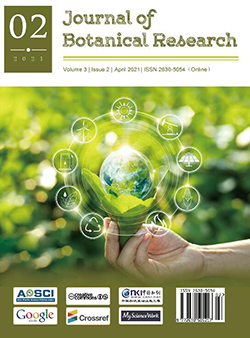-
28845
-
17504
-
3260
-
1194
-
1168
Response of Stubble Shaving Times on Ratoon Yield of Different Sugarcane Genotypes
DOI:
https://doi.org/10.30564/jbr.v3i2.2991Abstract
Ratooning is common practice done in sugarcane with purpose of reducing the total cost of cultivation and early cane maturity. More than 35% of sugarcane productivity is lost due to improper attention of the farmers towards ratoons. Majority of farmers reported that the ratoonability wasn’t good when harvested in December-January. This experiment was carried out to find the appropriate ratoon shaving time with response to different varieties in sugarcane ratoon crop in the year 2018/19 at national sugarcane research project, Jitpur, Bara. The experiment was conducted in split plot design with four levels of cane genotypes as Co – 0238, CoLk – 94184, Co – 0233 and CoS – 07250 as the main plot factor while four harvesting dates as sub plot factor with three replications. Observations of a number of millable canes, single cane weight, plant height and single cane diameter were recorded, tabulated and analyzed in R-studio. Ratoon stubble shaving in the month of November had the highest number of millable canes (88079/ha) which wasn’t significantly different from the stubble shaving in the month of December, January. Likewise, highest cane yield (60.04 mt/ha), single cane weight (0.757 kg), cane diameter (2.11 cm), plant height (1.82 m) were found in early stubble shaving dates. Cane Yield and various yield parameter shows better performance in early ratoon shaving periods i.e. from November to January than late ratoon shaving dates.
Keywords:
Sugarcane, Yield, Stubble, Ratoon, DatesReferences
[1] Bakker, H. (1999). Sugarcane cultivation and management, 207. New York: Springer.
[2] Chapman, L. S. Ferraris, R. and Ludlow, M. M. “Ratooning Ability of Cane Varieties, Variation in Yield and Yield Components,” Proceedings of Australian Society Sugar Technology, Vol. 14, 1992, pp. 130-138.
[3] Chapman, L., Ferraris, R., & Ludlow, M. (1992). Ratooning ability of cane varieties: variation in yield and yield components.
[4] FAOSTAT, (2014). FAO Statistical Database (FAOSTAT). Food and Agriculture Organization of the United Nations.
[5] Junej, SG. Kaloi, M. Panhwar, RN. Chohan, M. Junejo, AA. Soomro, AF. (2010)Performance of newly developed sugarcane genotypes for some qualitative and quantitative traits under Thatta conditions Journal of Plant Animal Science. 20(1): 40-43.
[6] Malik, K.B. (1997) Profitable cultivation of sugarcane. Directorate of Agriculture Information, Agriculture Department . Punjab, Lahore: 49.
[7] MoAD, 2016. Krishi diary, Agricultural information and communication center, Hariharbhawan, Lalitpur, Nepal.
[8] Ongin’jo, E., & Olweny, C. (2011). Determination of optimum harvesting age for sugarcane ratoon crop at the Kenyan Coast. Journal of Microbiology and Biotechnology Research, 1(2), 113-118.
[9] Rehman, A. and Ullah, E. (2008) Increasing yield of ratoon sugarcane. DAWN -Business; April 07, 2008.
[10] Saeed, M. (1993). Yield potential of second ratoon of promising varieties of sugarcane. Thesis. M.Sc. (Hons.) Agriculture, Department of Agronomy, University of Agriculture, Faisalabad.
[11] Shukla, S., & Lal, M. (2002). Competition functions and productivity in sugarcane-based associative and successive cropping systems in relation to nitrogen and sulphur nutrition. Indian journal of agricultural science, 72(6), 315-318.
[12] Singh, P., Rai, R.K. Suman, A. Srivastava, T.K. Singh, K.P. and Yadav, R.L. (2013). Ratooning induced rhizospheric changes impede nutrient acquisition and growth in sugarcane ratoon crop during grand growth stage in sub-tropics. Sugar Tech 15(1): 52-64.
[13] Stokes, I.E, and Ashley, (1956). Agronomic practices influence stubble deterioration of sugarcane. Proceeding in international society of sugarcane Technology congress 9: 255-271.
[14] Yadav, R.L. (1991). Sugarcane Production Technology; Constraints and Potentialities. Oxord & IBH Publishing Co. (Pvt.) Ltd. Bombay: 204.




 Abhisek Shrestha
Abhisek Shrestha





